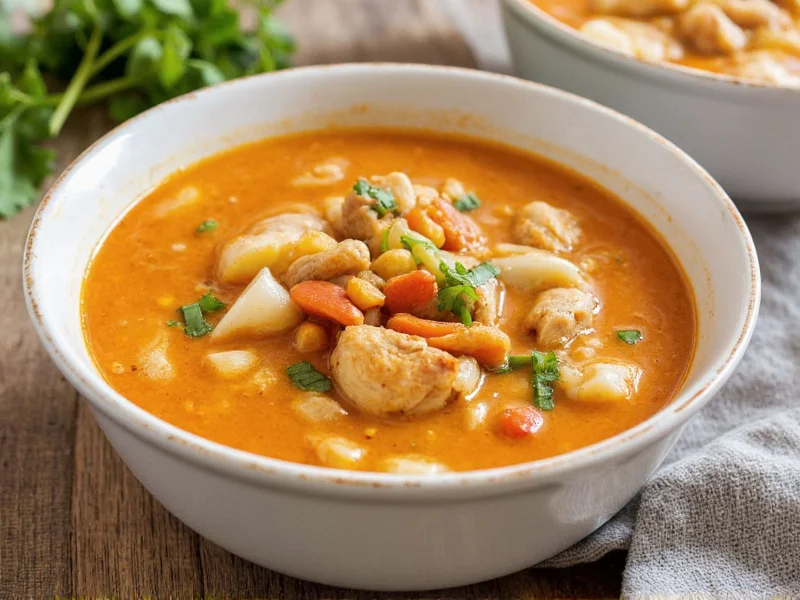Chicken soup represents one of the world's most universal comfort foods, with variations appearing in nearly every culinary tradition. The magic of chicken soup lies in its remarkable versatility—transforming simple ingredients into deeply flavorful, nourishing meals through proper technique. Understanding the fundamentals of broth development, ingredient timing, and cultural variations elevates your chicken soup from ordinary to extraordinary.
The Science Behind Satisfying Chicken Soup
Professional chefs and home cooks alike recognize that exceptional chicken soup begins with understanding the chemical reactions that create depth of flavor. When chicken bones simmer slowly, they release collagen that converts to gelatin, creating that signature rich mouthfeel. The Maillard reaction—occurring when proteins and sugars brown during initial searing—generates complex flavor compounds that form the soup's aromatic foundation.
For clear broths, maintain a gentle simmer rather than a rolling boil, which emulsifies fat into the liquid. Skim impurities during the first 20 minutes of cooking for crystal-clear results. Acidic ingredients like tomatoes or lemon juice should be added near the end of cooking to preserve their bright flavor profile.
Essential Components of Perfect Chicken Soup
Mastering chicken soup requires attention to three critical elements: the broth foundation, protein preparation, and vegetable incorporation. Each component demands specific timing and technique to achieve balanced flavor.
| Component | Key Ingredients | Preparation Tips |
|---|---|---|
| Broth Foundation | Chicken bones, aromatics, water | Simmer 4-6 hours for optimal extraction; add 1 tbsp vinegar to draw out minerals |
| Protein Element | Boneless chicken thighs, shredded rotisserie chicken | Add pre-cooked chicken during final 10 minutes to prevent toughness |
| Vegetable Medley | Carrots, celery, onions, garlic | Add root vegetables first, delicate herbs last; maintain 1:1:1 ratio for balance |
Classic Chicken Soup Recipes Worth Mastering
Every culinary tradition offers distinctive chicken soup variations, each with signature ingredients and preparation methods. These foundational recipes provide starting points for endless customization.
American-Style Chicken Noodle Soup
This beloved comfort food features egg noodles in a clear broth with tender chicken and vegetables. For authentic results, use a combination of chicken backs and wings for the broth, then add poached breast meat toward the end. The secret to exceptional chicken noodle soup lies in adding fresh dill and a splash of lemon juice just before serving—this brightens the entire flavor profile without making the soup taste citrusy.
Mexican Chicken Tortilla Soup
Originating in Mexico City, this vibrant soup features shredded chicken in a tomato-chipotle broth topped with crispy tortilla strips. Traditional preparation involves roasting tomatoes, onions, and garlic before blending them into the broth base. Authentic versions use epazote—a distinctive Mexican herb—or substitute with oregano and cumin. For optimal texture, add the tortilla strips immediately before serving to maintain their crunch.
Asian-Inspired Chicken Congee
This Chinese rice porridge transforms simple ingredients into a deeply comforting meal. The key technique involves simmering rice in chicken broth for 2-3 hours until it completely breaks down, creating a creamy consistency without dairy. Top with shredded chicken, scallions, ginger, and a drizzle of sesame oil. For medicinal applications during illness, add goji berries and shiitake mushrooms which provide immune-supporting compounds.
Advanced Techniques for Flavor Development
Professional kitchens employ several techniques to elevate chicken soup beyond basic recipes. The "mirepoix" foundation—equal parts onions, carrots, and celery—creates aromatic depth when sautéed before adding liquid. For richer flavor, try "concassé"—dicing vegetables uniformly to ensure even cooking.
"Mounting" with butter at the end (adding cold butter cubes while whisking) creates a velvety texture without heaviness. When preparing creamy chicken soup recipes, puree cooked cauliflower instead of using heavy cream for a lighter, nutrient-dense alternative that maintains creaminess.
Nutritional Benefits and Medicinal Properties
Research confirms what generations have known—chicken soup provides measurable health benefits beyond simple comfort. The steam helps clear nasal passages, while the warm liquid promotes hydration. Amino acids like cysteine released during cooking may help reduce inflammation associated with upper respiratory infections.
Homemade chicken soup contains significantly more nutrients than canned varieties, with higher levels of protein, vitamins, and minerals. The collagen-rich broth supports joint health and gut integrity, while the combination of vegetables provides antioxidants that boost immune function. For maximum nutritional benefit, include dark leafy greens like kale or spinach during the final minutes of cooking.
Avoiding Common Chicken Soup Mistakes
Even experienced cooks make preventable errors that compromise soup quality. Adding salt too early concentrates as liquid evaporates, resulting in oversalted soup. Instead, season in stages, with final adjustments before serving.
Overcooking vegetables destroys both texture and nutrients—add delicate ingredients like peas or fresh herbs during the last 5 minutes. Using only breast meat creates dry, stringy results; incorporate thigh meat or wings for better moisture retention and flavor development. Finally, rushing the broth preparation yields thin, flavorless results—allow at least 3 hours for proper extraction.
Storage and Reheating Best Practices
Proper storage maintains both safety and quality. Cool soup rapidly by placing the pot in an ice bath before refrigerating. Store in airtight containers for up to 4 days or freeze for 3 months. When freezing, leave 1-inch headspace for expansion.
Reheat gently over medium-low heat to preserve texture—boiling can make chicken tough and vegetables mushy. For frozen soup, thaw overnight in the refrigerator before reheating. Cream-based soups require special attention; stir frequently during reheating to prevent separation, and consider adding a splash of broth or milk if the texture thickens excessively.
Creative Variations for Every Season
Adapt your chicken soup recipes to match seasonal ingredients and preferences. In spring, incorporate fresh asparagus and peas with light lemon broth. Summer versions shine with ripe tomatoes and fresh basil in chilled gazpacho-style preparations. Autumn calls for roasted root vegetables and warming spices like sage and thyme. Winter demands heartier versions with barley, potatoes, and robust herbs.
For dietary adaptations, create gluten-free versions using rice noodles or quinoa. Dairy-free creamy soups work beautifully with pureed white beans or coconut milk. Low-sodium versions benefit from extra herbs and citrus to compensate for reduced salt.











 浙公网安备
33010002000092号
浙公网安备
33010002000092号 浙B2-20120091-4
浙B2-20120091-4